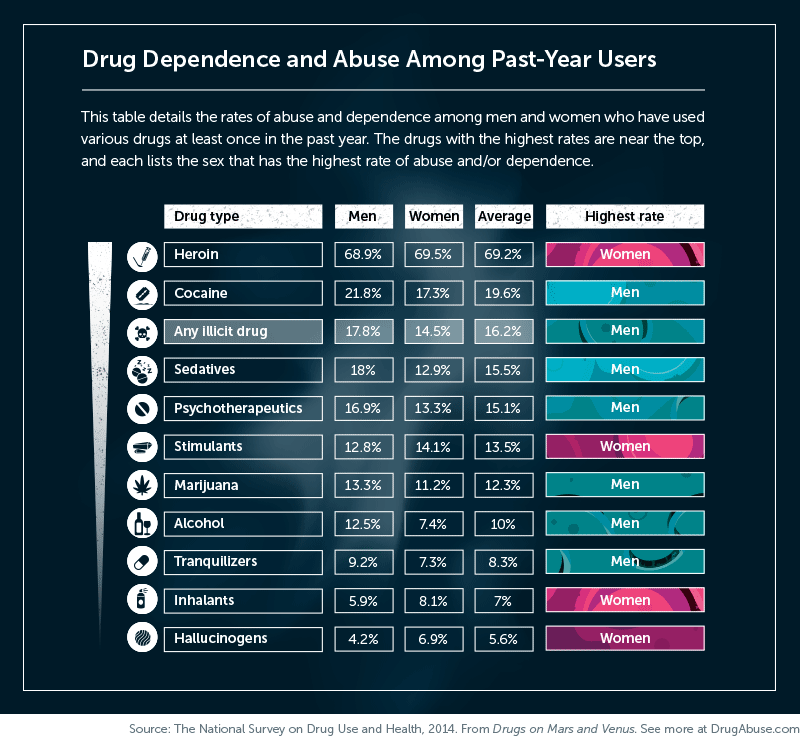Research and the collective experience of thousands of addiction treatment specialists all agree that almost any man or woman has the potential to become addicted to almost any substance, activity or object. There are however, some addictions whose rate of susceptibility may be affected by the hormonal and physiological and also the psychological differences that are normally found between men and women. While addiction does not discriminate, the susceptibility of men and women to any number of addictions to various substances and activities does indeed vary depending on gender. Research continues to demonstrate that there really are uniquely male and female risk factors associated with the various habit-forming conditions. Extensive studies also confirm that both males and females are different in their motives to use drugs or other substances, their vulnerability to addiction, and also in their physical and mental reactions to the various addiction treatment therapies. At the moment, it appears that the key substance that is driving the current research is dopamine. Dopamine release is one of the key chemicals that are behind the changes that occur in the rewards system of the brain, which is extensively altered during the course of nearly any addiction. The release of dopamine is why humans continue to repeat behaviors that cause its release, and it is believed that this evolved as an adaptive response for early humans to recognize the need to eat or participate in sex. Dopamine release is then considered part of the survival system of the human brain and dopamine release plays a part not only in the development and reinforcement of many addictions, but dopamine release also plays a part in many other physical and mental illnesses. Abnormalities in dopamine production and / or release may even partially explain why those who suffer from various mental illnesses seem to have a greater propensity for various addictions. The sensations that we experience as the result of having sex or eating, the feeling of satisfaction, comes from the release of dopamine that sexual activity and eating release in the brain. The same thing occurs in many types of addiction, as even thinking about obtaining the addictive substance or habit can cause the release of dopamine in the brain. While both males and females produce dopamine, the way that this substance interacts within the brain and body of males and females varies greatly due to the production and effects of various hormones that are also released in the bodies of males and females. Two hormones that are responsible for many of the characteristics of gender, estrogen and testosterone, both affect the levels of dopamine released and how it is released. Because of this link between hormones and the fact that the amount that is produced by each of these hormones is determined by one’s gender reinforces the link between addiction and dopamine release and demonstrated the difference between the sexes as to how and why they use drugs. A prime example of this is cocaine. Studies reveal that women tend to use cocaine to self-medicate when feeling depressed and unhappy, when their levels of estrogen are fluctuating. Men, on the other hand, generally use cocaine when they are feeling good; in order to feel even better, and happiness in men has been linked to an increase in circulating testosterone levels. Both hormone release and how they affect the release of dopamine then affect the way addiction to cocaine plays out in men and women. Nicotine addiction is another area where gender differences affect the addiction. Studies show that women use smoking to regulate their mood and suppress their appetite, while men generally smoke to improve their attention and performance at work and also to relieve feelings of anger or sensations of pain. Again, the hormones of estrogen and testosterone and how they affect the release of dopamine play a large part for the differences in susceptibility to addiction in men and women who smoke. The susceptibility for alcohol abuse is yet another area where men and women differ, as women begin drinking to compensate for feelings of emptiness or loneliness and men tend to use alcohol like cocaine in that it is used to either relax or to celebrate sensations of happiness or to increase feelings of confidence. Nearly all substances and activities are now showing a clear link between dopamine release and how male and female hormones affect the progress and treatment of the addiction.
Susceptibility to Addiction


